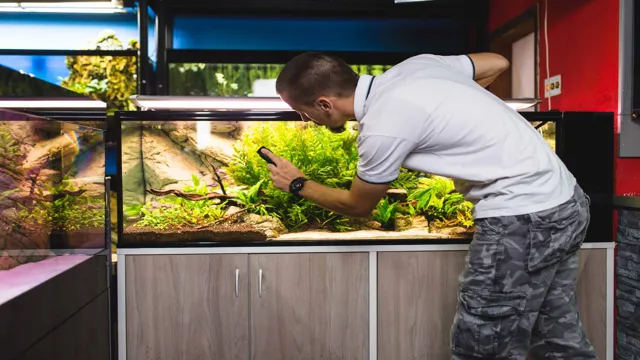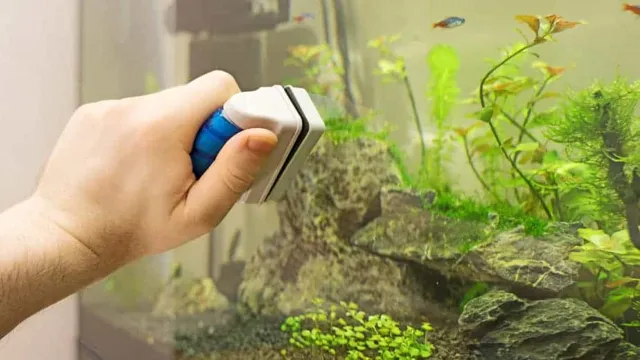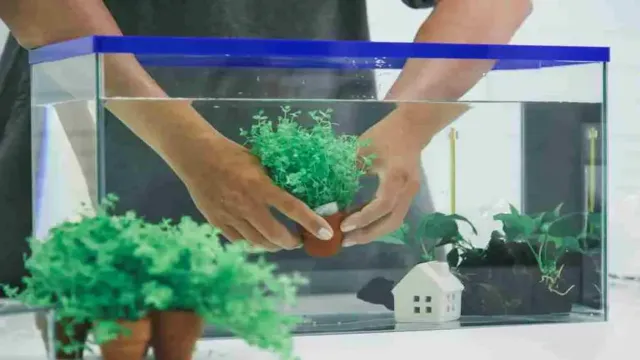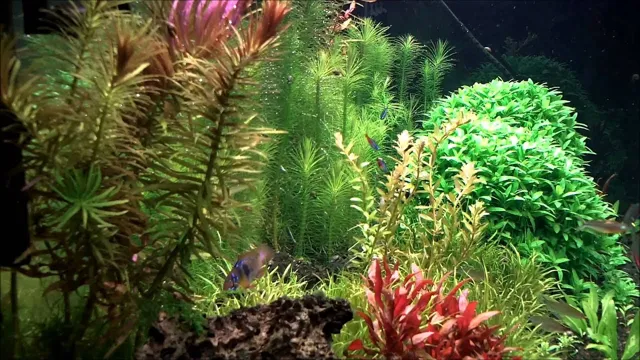Aquascaping is a popular hobby for fish enthusiasts. Creating an underwater garden that looks like a natural habitat for your fish can be incredibly satisfying. However, maintaining an aquascaped aquarium can be quite challenging.
With all the plants, rocks, and ornaments, it can be tough to keep everything clean and healthy for your fish to thrive. In this blog, we’ll discuss different ways on how to clean an aquascaped aquarium to ensure that your fish have a happy and healthy home. Let’s dive in!
Preparing for Cleaning
Aquascaping can create a stunning and visually appealing aquarium, but it can also make cleaning a bit trickier. To prepare for cleaning, the first step is to remove any décor or plants that may get in the way. Keep them in a separate container filled with aquarium water to prevent them from drying out or getting damaged.
Next, turn off all equipment, including filters, heaters, and pumps. Allow them to cool down before handling them to avoid any injuries or damage to the equipment. Once everything is turned off, drain the water slowly, making sure to leave a small amount at the bottom to prevent any beneficial bacteria from dying off.
Be sure to clean the gravel, removing any debris or uneaten food, and scrub the aquarium walls with a sponge or scraper. You can also use an algae scraper to remove any stubborn algae buildup. Once everything is clean, replace the water, ensuring the temperature and chemical composition are correct before reintroducing any plants or fish.
With these simple steps, cleaning an aquascaped aquarium can be a breeze.
Removing Plants and Decorations
When preparing to clean your aquarium, it’s important to remove any plants and decorations beforehand. Not only will this make the cleaning process much easier, but it also gives you the opportunity to inspect and clean each item thoroughly. Begin by carefully removing any plants or ornaments from the tank and placing them in a separate container filled with aquarium water.
This will prevent them from drying out and potentially dying. Inspect each item for any signs of damage or buildup, such as algae or sediment. Use a soft brush or cloth to gently clean each item, being careful not to damage any delicate decorations.
By taking the time to properly prepare your aquarium for cleaning, you can ensure that your fish will have a healthy and clean environment to live in.

Draining the Water and Removing Fish
Preparing for cleaning is an essential step before draining the water and removing fish from your pond. To make this process easier, it’s advisable to invest in a good pond net, which will help you catch the fish without harming them. Before you begin, ensure that you have a separate container to place the fish once you catch them.
It’s important to keep in mind that fish can get stressed out from the handling and transport, so minimizing their exposure to air and sunlight is crucial. Once you have the net in place, start removing any debris or fallen leaves that might have collected at the bottom of your pond. This will make the water clearer and easier to see the fish.
With everything in place, it’s time to start draining the water from the pond. Don’t forget to turn off any pumps and filters to prevent them from getting damaged. As you remove the water, keep a close eye on the fish to ensure that they stay safe and secure in the container.
By taking the necessary precautions, you’ll be able to clean your pond without causing any harm to your beloved fish. (See Also: How to Control Temperature in Aquarium: Tips and Techniques for Beginners)
Cleaning the Aquarium
Cleaning your aquarium, especially one that has been aquascaped, can be a daunting task. But, it’s essential for maintaining a healthy and beautiful habitat for your aquatic pets. The first step is to remove any debris and excess algae from the tank walls and decorations using a scraper or brush.
Then, carefully siphon out about 25% of the water into a clean bucket, making sure not to disturb the substrate or plants. Next, it’s time to clean the filter. Turn off the filter and remove the media.
Rinse it with dechlorinated water and replace it back in the filter. Lastly, add fresh, dechlorinated water to the tank, making sure it’s the same temperature and pH as the water that was removed. Don’t forget to add in any necessary water conditioner or supplements.
By following these steps, you can keep your aquascape looking pristine and your fish healthy.
Scraping Algae
Scraping algae is an essential task for any aquarium owner looking to maintain a healthy living environment for their aquatic friends. While the growth of algae is a natural process, it is unsightly and can quickly get out of hand, affecting the quality of the water. Moreover, algae can block the light reaching the plants in the aquarium, which can be detrimental to their growth.
To clean the aquarium, you can start by removing any decorative elements, such as rocks or plants, and place them in a separate container. Then, using a scraper or brush, gently remove the algae from the sides of the tank. Be sure to clean the filter and change the water regularly to avoid the accumulation of algae.
Keeping the aquarium clean ensures that your fish and plants stay healthy and beautiful. So, what are you waiting for? Grab that scraper and start scraping away!
Cleaning the Glass
Cleaning the glass in your aquarium is an essential part of maintaining a healthy and aesthetically pleasing environment for your aquatic pets. Not only does a dirty tank make it difficult to enjoy the beauty of your fish, but it can also negatively impact their health. To clean the glass, start by turning off all electrical equipment and unplug any cords that may be in the way.
Next, use an algae scraper or razor blade to gently remove any buildup on the glass. Be sure to use a gentle touch and avoid pressing too hard as this can cause scratches. After cleaning the algae, use a clean cloth or sponge to wipe down the glass with a solution of vinegar and water.
This will not only remove any remaining buildup but also help to disinfect the glass. Finally, rinse the glass thoroughly with water before plugging in any electrical equipment and turning it back on. With a little bit of elbow grease, your aquarium will be looking as good as new in no time!
Cleaning Gravel and Substrate
Cleaning your aquarium regularly is essential in maintaining a healthy and beautiful aquatic environment for your fish and plants. One crucial part of aquarium maintenance is cleaning the gravel and substrate. These materials are often home to beneficial bacteria that help keep the aquarium clean, but they can also accumulate debris and waste over time.
To clean the gravel and substrate, use a gravel vacuum to siphon out any dirt and waste without disturbing the gravel itself. Be sure to also spot-clean any areas with particularly stubborn debris. Regularly cleaning the gravel and substrate not only improves the aesthetics of your aquarium, but it also ensures a healthy and balanced environment for your aquatic pets. (See Also: How to Get Rid of Hair Worms in Aquarium: Tips and Tricks for a Clear and Healthy Tank)
Replacing Water and Plants
If you have recently aquascaped your aquarium and you want to keep it looking clean and fresh, there are a few things you can do to maintain it. One of the most important steps is to replace the water and plants, which will help to remove any excess debris that has accumulated in the tank. You can start by removing the old water and adding new fresh water in the tank.
You should also replace any plants that have begun to rot or decay. Make sure to trim any dead leaves or branches from the plants that you want to keep, as this can help to improve their overall health. It’s important to use a high-quality water conditioner and aquarium salt to ensure that the water in your tank is balanced and healthy for your fish and plants.
By following these simple steps, you can keep your aquascaped aquarium looking beautiful for years to come.
Refilling and Treating the Water
When it comes to maintaining your aquatic ecosystem, it’s essential to replace water and plants periodically. Over time, the water in your tank can become stale and contaminated with waste, while plants can eventually die off and decompose, releasing harmful substances into the water. To remedy this, you should aim to replace 10-20% of the tank’s water every week or two, depending on the size of the tank and the number of inhabitants.
When doing so, be sure to treat the new water with a dechlorinator and adjust the temperature to match that of the existing water before adding it to the tank. Additionally, if you notice any dead or dying plants, remove them promptly and replace them with new ones, taking care to avoid overcrowding. Doing these simple tasks regularly will help keep your aquatic ecosystem healthy and thriving for years to come.
Adding Plants and Decorations
When it comes to maintaining a healthy and vibrant aquarium, replacing the water and plants is crucial. It’s recommended to change the water approximately every two weeks, depending on the size of your tank and the number of fish you have. Before replacing the water, it’s important to vacuum the gravel, removing any debris or uneaten food that may have accumulated.
It’s also a good time to trim any dead or dying leaves from your plants, as this can help promote new growth. When replacing the water, it’s best to use a water conditioner to remove any harmful chemicals, such as chlorine, that may be present. Adding new plants or decorations can also help create a more visually appealing environment for your fish, while providing them with new hiding spots and areas to explore.
Just be sure to thoroughly rinse any new items before placing them in the tank to prevent introducing any unwanted bacteria or pollutants. With a little care and attention, your aquarium can thrive for years to come.
Maintaining a Clean Aquarium
Maintaining a clean aquarium can be quite a task, especially if you have an aquascaped one. However, it is a necessary component of ensuring a healthy environment for your aquatic pets. Start with removing any large debris, such as dead leaves or uneaten food, using a net or siphon.
For an aquascaped aquarium, be mindful of any delicate plants and decorations while doing this. Next, perform a partial water change of about 20%-25% of the total volume. This will ensure that waste and excess nutrients are removed from the tank.
Use an aquarium gravel vacuum to remove any excess waste from the substrate. It is also essential to clean the filter, as it is the heart of the aquarium’s cleaning system. Switch off the filter, remove the media, and rinse it in a bucket of water.
Never use hot water or detergents as this can kill beneficial bacteria. Lastly, test the water’s parameters using a reliable aquarium test kit to ensure everything is within the fish’s tolerance levels. Follow these steps, and your aquascaped aquarium will stay clean and healthy for your aquatic pets to thrive. (See Also: How to Get the Best Color out of Aquarium Shrimp: Tips and Tricks)
Conclusion
In conclusion, cleaning an aquascaped aquarium requires a delicate balance of care and precision. It’s like tidying up a miniature jungle in your own home – you don’t want to disturb the natural order of things, but you also don’t want to let things get out of control. So, grab your trusty cleaning tools, roll up your sleeves, and get to work with a steady hand and a keen eye for detail.
With a little bit of patience and a lot of love for your aquatic friends, you’ll have a sparkling clean tank that will be the envy of all your fish-loving friends. Happy cleaning!”
FAQs
What tools do I need to clean an aquarium that has been aquascaped?
To clean an aquascaped aquarium, you will need a gravel vacuum, algae scraper, fishnet, and clean water buckets.
How often should I clean my aquascaped aquarium?
It is recommended to do a partial water change and gravel vacuuming every other week. However, the frequency may vary depending on the number of plants and fish in the aquarium.
Can I remove the plants from my aquascaped aquarium while cleaning it?
It is best not to disturb the plants and their rooting system as it can cause stress and damage. You can clean around the plants or use an algae scraper to clean the glass.
How do I remove excess algae from my aquascaped aquarium?
You can use an algae scraper or magnetic cleaner to remove excess algae from the glass and plants. Additionally, introducing siamese algae eaters or amano shrimp can help control algae growth.
Should I remove my fish from the aquarium while cleaning it?
If possible, it is best to remove the fish during the cleaning process to avoid stressing them out. However, if you cannot, cover the aquarium with a blanket or towel to reduce stress.
How do I prevent algae growth in my aquascaped aquarium?
You can prevent algae growth by maintaining proper lighting, controlling nutrient levels, and adding enough plants to the aquarium.
Can I use chemical cleaners to clean my aquascaped aquarium?
It is not recommended to use chemical cleaners as they can harm fish and plants. Stick to using simple tools like gravel vacuum and algae scraper to clean the aquarium.







